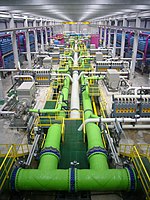
Photo from wikipedia
Abstract Here, we show that high permeability and good fouling resistance can save substantial energy and maximize freshwater output for reverse osmosis (RO) desalination of low-salinity wastewater, via both theoretical… Click to show full abstract
Abstract Here, we show that high permeability and good fouling resistance can save substantial energy and maximize freshwater output for reverse osmosis (RO) desalination of low-salinity wastewater, via both theoretical and experimental demonstrations. First, module-scale modelling revealed that at reasonably low feed salinity, the specific energy consumption (SEC) drops by > 60% when water permeability is increased from 2 to 7 L m−2 hr−1 bar−1. Optimization of different operating parameters was further performed to maximize the energy efficiency and process capacity, and suitable salt rejection to maintain permeate quality was evaluated. Next, we synthesized zwitterionic copolymers of different molecular weight and fabricated hollow fiber membranes with a pure water permeability of 8.6 L m−2 hr−1 bar−1, 98.5% rejection to NaCl, and excellent fouling resistance. 85% water recovery, 56% energy saving and 25% reduction of membrane area were demonstrated for treating membrane bioreactor (MBR) filtrate from a local water reclamation plant.
Journal Title: Journal of Membrane Science
Year Published: 2021
Link to full text (if available)
Share on Social Media: Sign Up to like & get
recommendations!